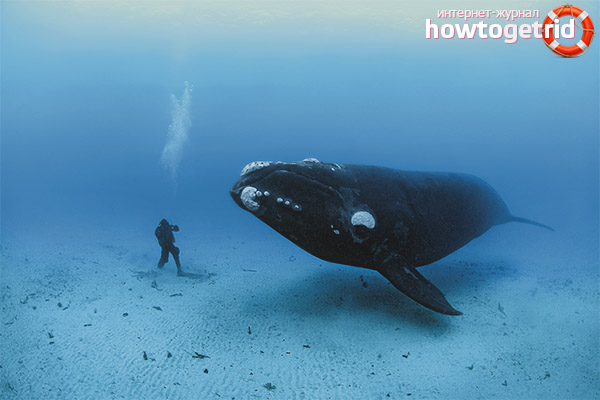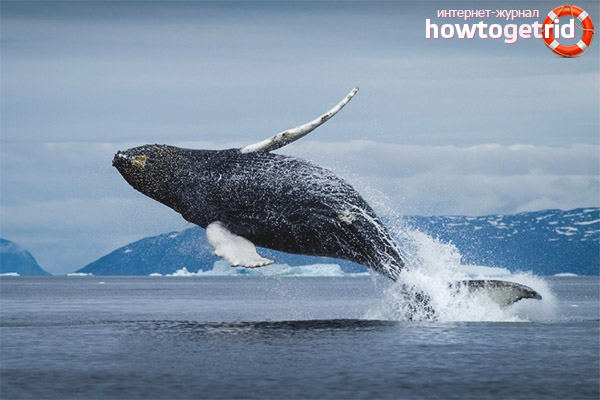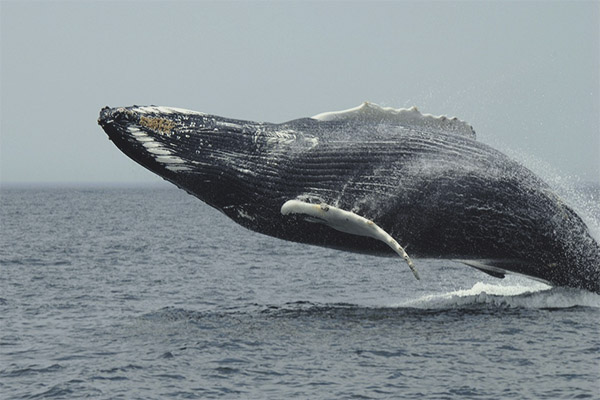The content of the article
Life on Earth originated in water many hundreds of millions of years ago, but as time passed, in the course of evolution, marine inhabitants moved to dry land and began to develop on land. But the proud and majestic whales, which are perhaps the largest animals on the planet, remained to live in the oceans of the planet. And in all the oceans, even the northern ones. In conditions little suitable for life, among the eternal cold and cold lives one of the species - bowhead whales.
Not so long ago, the Greenland (or polar) whale — some 150–200 years ago — was found throughout the Arctic Ocean in large quantities. Sailing vessels, literally, were maneuvering in all directions between swimming fish. In modern times, they have become much smaller, according to scientists - no more than ten or eleven thousand. What is this marine waterfowl?
Description and appearance
Description of the bowhead whale is to start with the size, and they are impressive - the males reach a length of 18-19 meters, and the females of these animals are slightly larger - their length can be 22-23 meters. Adult whales gain weight up to 100 tons, but this is not the limit - some specimens have a mass of 150 tons.
The skull of an animal is very massive, its length is almost a third of the total length of the body, tiny eyes are located at both edges of the huge mouth. The lower U-shaped jaw is slightly larger than the upper, slightly protruding. All organs of touch - vibrissae (popularly called whale whiskers) are located on it. They are very thin and rather long - 5-5.5 meters, there are more than three hundred of them. The muzzle of the animal by the end narrows and sharpens.
The animal has no pronounced ears, but the ear is excellent. The device of an internal ear allows to perceive sound waves not only in a habitual format and in a big range, but also in ultrasound.
On the crown of the head of a gigantic fish there is a breathing hole - two not very large gaps through which the whale with great force releases six-meter fountains of seawater. The strength of the liquid produced is so powerful that the jet breaks through ice thirty centimeters thick.
The body of the fish is smooth-flowing, blue and gray in color.This type of whale on the skin does not have growths and bumps, so any parasites such as small crustaceans and whale lice do not cling to the body and do not reproduce.
There is no fin on the back of the marine inhabitant, but there are two humps. They are clearly visible when looking at the whale from the side. Pectoral fins look like oars - wide, not very long and with rounded tips. The giant's heart is huge - it’s about a passenger car and weighs about half a ton.
Under the skin of an animal there is an impressive layer - up to 70 centimeters - of fat, which serves as a reliable protection from the deadly cold of the northern seas and oceans.
The tail is about nine meters, the tips are pointed, and there is a depression in the middle.
Way of life, character
The advantages of this method of movement is that in this way it is easier to push away the ice and overcome obstacles in the way. And as soon as autumn comes, they migrate back to the southern regions of the northern seas.
Although whales are gregarious, everyone lives by itself, constantly searching for food. To do this, they dive as deep as possible, gain a full mouth of water, then swim out, releasing huge water fountains. They come up in an interesting way: first a gigantic head appears outside, then a part of the body. Then the whale, turning on its side, falls sharply on him.
Like any mammal, a whale sometimes sleeps - before going to sleep it rises as high as possible and falls asleep. A body with a good supply of fat, perfectly kept on the water surface. Over time, it slowly goes down. Reaching a certain depth, the whale strikes its tail, rises to the top and everything repeats until the fish get enough sleep.
Nutrition

The diet of the bowhead polar whales is an animal, it includes small crustaceans and crustaceans, fry, eggs, zooplankton, krill, and sometimes there are benthic organisms.The process of eating is as follows: the whale sinks to the depth, opens its mouth wide and swims, filtering water that has entered the mouth. Within a minute, a whale can filter out up to 50 thousand organisms. The contents deposited on the whiskers are immediately sent to the stomach via the tongue. To feel full, the whale needs about two tons of food per day.
By the fall, the whales accumulate a huge layer of fat, it helps them live until spring and not die of starvation.
Breeding
Whales are polygamous, males become sexually mature at about 21-22 years. And in this issue, females overtake the male sex - to them, puberty comes a few years early. The mating season begins at the end of February, the males attract females, performing songs of their own composition. And each season they come up with new ones.
Pregnancy lasts 13-15 months, the next spring, most often in May, a kitten is born. The baby is round, like a barrel, a little brightened by the parents, the length of the body of a newborn is 4.3-5.3 meters. The cub grows one and a half centimeters a day, while the mother feeds with milk. It is similar in thickness to the toothpaste and very fat - more than 50 percent.Maternal feeding lasts just over a year.
Parent behaves like a very caring mother, being all the time next to the child, feeding him and protecting him from dangers. Seeing the enemy nearby (say, the killer whale), an angry mother drives her away, hitting her with a long tail.
Whales and the ecosystem
The role of the bowhead whale in the ecosystem of the Arctic Ocean is important - it acts as a regulator of zooplankton.
Economic value, pros and cons
Cetaceans have always been of great value to humans - from time immemorial whalers have beaten the whales and mined meat, whale oil, and a rather valuable whalebone. With its large size, the polar whale gives it all in large quantities. Many local residents living in the northern regions (for example, the Eskimos) depended heavily on these animals, because thanks to them they had food, fuel and were able to make tools of labor.
Minuses
The only negative factor can be called only the cases when animals passing by prevented a person from engaging in fishing and harvesting fish - they frightened and banished shoals.Sometimes it happened that the whales were confronted with boats and fishing vessels and got into the network, not intended for them.
How many whales live

The bowhead whale has the longest life expectancy among all mammals. Thus, the average age of the killed individuals was 70-80 years, and after studying the nucleus of the eyes, zoological scientists came to the conclusion that these animals easily live to two hundred years, since there are very few diseases in the world that shorten life to these beauties.
Whale Guard
Since the 17th century, when people began to massively destroy whales for good money, a lot of all kinds of individuals were destroyed. In the 70s of the 20th century, whales were listed in the Red Book as an endangered species and became protected by law. Currently, animal hunting is strictly limited.
Interesting
Their eyesight is disgusting, the scent is the same - whales do not smell.
Whale speed is low - about twenty kilometers per hour.
Sometimes among whales there are cases of pseudohermaphroditism - this is when the female organs begin to form in the females inherent in males.
The whales, due to their huge size, have no enemies - not a single predator wants to get involved with such a giant. The only ones who sometimes try to attack the animals are the killer whales.
Video: bowhead whale (Balaena mysticetus)











To send